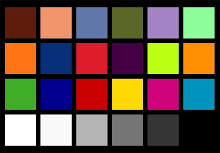
I have been lucky enough to have gotten my hands on Arri's new ALEXA digital cinema camera. Actually, I've done three separate jobs with the ALEXA so far and am starting another one tomorrow. For about six months I have been waiting with baited breath in anticipation of this camera system. I had hoped it would deliver. I had at least pleaded that it would deliver 75% on its promises. I can tell you right now, unequivocally, that this camera, simply stated: over-delivers.
Everything you may have heard is true... and then some. This is the new standard for digital acquisition. I can say, for the first time, that this camera looks as good as 35mm film. In fact, I doubt that anyone could tell the difference between properly lit and exposed 35mm negative and properly lit and exposed ALEXA Log C capture. This is the first digital cinema camera. Period. It does not look like a video camera. It is smooth and silky. Much like film. And has such unbelievable dynamic range that you will crap yourself if you haven't already.
Arri has outdone themselves. This is a company that I have always admired. That I have always put at the top of any list. This company does not sit still. They are constantly evolving and pushing the boundaries. However, they are German. And being German requires a certain level of commitment to excellence. Sometimes this commitment can be an Achilles heel. For example, the 35mm BL was a workhorse of a camera, but it needed to be replaced. So Arri introduced the 535a, a 35mm film camera built like a tank and weighing almost as much. It had an electronically adjustable shutter, speed ramping, arriglow, a huge and bright viewfinder, etc. All of the specs screamed perfection, but the camera was just too damn big and bulky. Have you every tried a hand-held shot with a 535a and a 400ft mag? How about riding one on a steadicam? The thing just kills. About ten years later Arri introduces the Arricam ST and LT. C'mon. We can say it together: The Arricam LT is the best 35mm sync-sound motion picture camera ever designed and built. Period. And so it was with the Arri D-20. A great design on paper, but not so much on location. The D-21 proved Arri's point that it could produce a digital camera that looked great. As long as it was a day exterior or you had an uber budget for G&E.
So here we are. It's September of 2010 and Christmas has come early. Arri has produced the standard. Nothing else even comes close. Out of the box the ALEXA is stunning. It is small, compact, well-designed, intuitive, simple, and elegant. It also happens to weigh quite a bit more than you'd think (I've gotten accustomed to calling it "The Brick"). But the weight adds confidence. This is a motion picture camera. It is not made of plastic and rubber. It will not crack or throw a tantrum. It was built like a tank (in a good way this time). And it has a soft side. The ALEXA's pictures are simply gorgeous. There is an incredible smoothness to this ALEV-III sensor that I've never seen before in digital cameras. The ALEXA is sharp, of course, but not like a F35. It is a new world. And we should be happy.
This was a bit of school-boy gushing on my part but I just had to get it out. My next post will include an ASA/Gain test that I just finished this afternoon. With ALEXA's native 800 ASA sensitivity I wanted to objectively measure any reduced dynamic range under middle grey when the camera's ASA is set lower (like to 400 or even 200). From just observing the camera in the field I suspect that any reduction of DR is going to be purely academic, but I'll have the real data up soon and we can take a better look.
One last thought... I know there are those out there amongst us that may be impressed with the ALEXA but are still waiting on the next generation of digital cameras from RED. I admire your loyalty. I'm sure the Epic or the 83.2K Super Iliad will be just awesome. I am intrigued. That being said, there is not a lot that I would change on the ALEXA. I do not see much room for improvement. Resolution? Sure. But as any film professional will tell you there is more to resolution than merely resolution. Dynamic range, sharpness, contrast, all of these affect resolution. A higher K doesn't always add up. But one thing is for sure. When the history books are written our film scholars will no doubt note the impact that RED had on the future of digital cinema. Because without the RED ONE dropping into our laps those few short years ago we would never have Arri's ALEXA. Here's to more industry shake-ups!
And here's a few screen grabs from my last few ALEXA jobs...
These stills were captured from ALEXA's LOG C out, routed through a Cine-tal 24" Class 1 HD Monitor, color-corrected via SpeedGrade OnSet, and outputted to a QuickTime movie file. They represent a quick and dirty snapshot from a much more beautiful machine.

ALEXA @ ASA 320

ALEXA @ ASA 800

ALEXA @ ASA 400

ALEXA @ ASA 1600 with a Cooke S5i 24mm Lens at T1.4 and lit entirely with a source 4 backlight and a kino barfly about 15ft from our star.


The pictures of cameras that you uploaded in this blog spot are so lovely. arri alexas
ReplyDelete